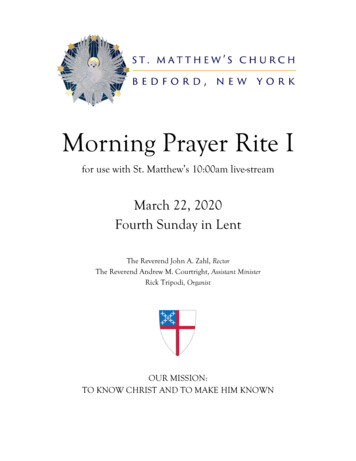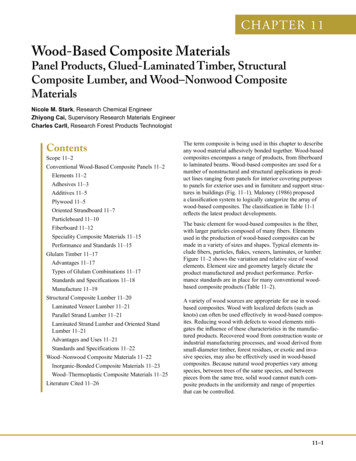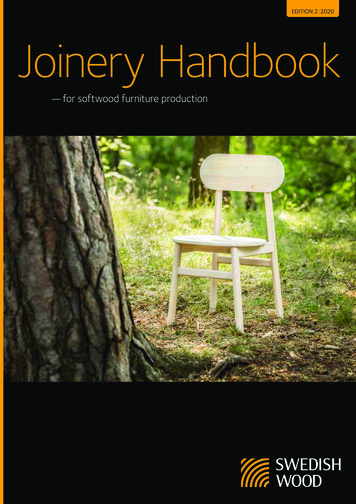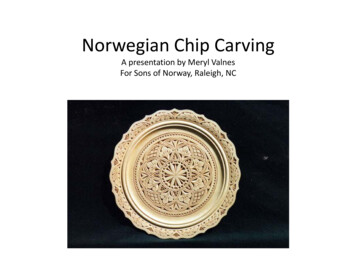
Transcription
The Reverend Wood visits the zooAnthony LeeJohn George Wood was the David Attenborough of his day.Before Wood, natural history was seen as uninteresting anddry, a matter of simply putting animals and plants into classes;after Wood the emphasis was on the behaviour of animals,a topic of much wider general interest. With little formaltraining in science, Wood became one of foremost Victorianpopularizers of science.1 And much of his knowledge ofnatural history was gained in Margate, at the sea shore and atthe Zoological Gardens.2Wood was born in 1827, the son of a surgeon.2 He studied atOxford with the intention of entering the church, graduatingin 1848. In 1852 he became curate of the parish of St. Thomasthe Martyr in a poor part of Oxford. His son tells that he foundhis stipend as a member of the clergy too low, at no morethan 60 per year, and so looked for ways of improving hisprospects.2 In 1851 he had published a book, The IllustratedNatural History, which met with sales which although ‘notphenomenal’ were at least felt to be ‘encouraging’ by boththe author and the publisher.2 In 1856 he became chaplain ofSt. Bartholomew’s Hospital London, where he remained for 6years, in a job where his duties ‘were not arduous’ giving himplenty of time to pursue his literary career. In 1857, Messrs.Routledge & Co. had the idea of publishing a series of shillingHandbooks on Natural History and asked Wood to write abook for the series. This he agreed to, producing CommonObjects of the Sea-shore. The book sold well, leading to asecond book for the series, Common Objects of the Country,which appeared in 1858. This was a spectacular success; thepublishers had printed a first edition of one hundred thousandcopies, but these sold out by the end of just the first week, tobe followed by many subsequent editions. Between 1868 and1876 Wood was precentor to the Canterbury Diocesan ChoralUnion. After 1876 he devoted himself to writing books andlecturing on zoology. His sketch lectures, as he called them,made him very popular both in the United Kingdom and inthe United States; he illustrated the lectures with drawingson a black-board or on large sheets of paper with colouredcrayons, a foretaste perhaps of the famous Australian, RolfHarris. In 1878 Wood moved to Upper Norwood, where helived until his death in 1889.It is not clear when Wood first visited Margate. We knowthat he visited frequently after his marriage in 1859, visitsmade because of his own poor health and that of his wife,2but it is very likely that he visited before this. His 1857 book,Common Objects of the Sea-shore, was based on ‘visits tothe sea-coasts for the last six or seven years,’3 and althoughin the book he does not mention any specific places, we knowWood was in Margate soon after the publication of the booksince his son relates the following incident:The Rev. John George WoodSoon after its publication, he was hard at work among the rockpools at Margate, a mallet and a chisel in his hand, his oldest coat on,and his trousers tucked up to his knees. Just as he was moving fromone pool to another, a small company of fashionably dressed youngladies approached, deeply intent upon a copy of his own “CommonObjects.” Just as they passed they looked up, saw the enthusiasticnaturalist in his working attire, shrugged their shoulders, elevatedtheir noses, and murmured, “How very disgusting!” And then theyreturned to their book.”2Wood frequently came back to the topic of the sea shore, andin 1862 he published an article Along the Margate Sands inThe Boy’s Own Magazine.4 Whilst agreeing that ‘Margate isby no means one of the localities which is celebrated for theproduction of marine rarities’ he felt thatno one who has a pair of eyes that can see two yards in front of them,and a decently competent brain behind them, need find himself inlack of amuse ment and instruction as he strolls along the Margatesands. For myself, I like them, and spend many hours in potteringabout them with bare feet and legs, and with an apparent absenceof any purpose. And purpose I have none, but just look about andwait for something to present itself. I have spent the whole of this
morning standing in two little pools some ten or twelve feet indiameter, and at most a foot in depth. The strollers on the sandsand the clamberers among the seaweed-clad rocks cannot make outmy object. I have no basket, no bottle, no pail, and no net, andwhen a curious person comes up and looks into the sandy pool hesees nothing at all, and goes away again, thinking me somewhatidiotic. Yet I have been greatly interested and amused for severalconsecutive hours. I have been watching the prawns and theirmanners and customs, and find them to be much more intelligentand full of purpose than I had previously imagined.After rather a lot about prawns, he turns to the crabs:With a few exceptions the crab is the master of the shore, and alarge, hard-shelled green crab must be as despotic as a Kaffir chief,who is certainly the most complete specimen of an earthly despot.But he has one dreaded enemy, from whom he is never safe unlesshe is under the sand or deep in the water. Just as the dark chief inquestion may be attacked and killed by a wild beast, so may the crabbe captured by a rat. The rocks above high-water mark are thicklyinhabited with rats. You can see their footmarks in the sand, andtrace them as far as the entrance to their habitations. Beyond thereis no chance of tracing them, for the clefts in which they live haveso many ramifications that if the animal should be traced into one,he can always escape by another.On one occasion, when a friend and myself were walking under thecliffs, we saw the fresh footprints of a rat, accompanied by strangemarks which we could not comprehend. After spending some littletime in investigation, the whole mystery was disclosed. Only a fewminutes before our arrival at the spot, a rat sallied from the cliffsand attacked a large crab that was making its way to the sea. Thecrab had shown fight, and struggled violently, but the superior forceof its enemy prevailed, and it had been dragged towards the cliff,its hook-like feet making furrows in the sand, and a slight groovebeing traced by the tail of the rat. In many clefts of the rock, limbsand other portions of crabs may be seen, showing that the rats havebeen successful in their raid, and have devoured the animal that hasdevoured so many lesser creatures.The other great attraction of Margate for Wood was themenagerie kept by Lord George Sanger, to which Wood wasa frequent visitor. ‘Indeed’ wrote his son, ‘While he was athome, he very seldom let a week pass without paying at leastone visit to his favorite animals.’2 The menagerie was partof the Hall-by-the-Sea, located on a site later occupied byDreamland. The Hall-by-the-Sea originated as the terminusof the London, Chatham & Dover Railway Company.Due to a disagreement with the South Eastern RailwayCompany, who had already built their terminus on the seafront at Margate, the LCDR were ordered to vacate theirterminus and rebuild on a site further away from the town.The vacated terminus was rented by the LCDR in 1867 toSpiers and Ponds, a major catering contractor of the time.They ran The Hall-by-the-Sea as a dance and concert hall,but without any great success. So, in 1870, they sold it to thethen Mayor of Margate, Alderman Thomas Dalby Reeve, aprominent local business man. Reeve’s son Arthur marriedHarriett Sanger, daughter of Lord George Sanger in 1873 andin 1874, Sanger took over the Hall. With the Hall came a lotof land, including a number of potato fields, with the unusedrailway embankment running right through the centre.5,6Sanger describes how he ‘went down to Margate, boughthalf-a-dozen bundles of wood, and pegged out the gardensand menagerie houses.’7In May 1874, Sanger advertised that the Hall-by-the-Sea,Italian and Zoological Gardens at Margate would open forthe season, from Whit Monday, May 25th. He reported that‘The magnificent Hall has been considerably enlarged in sucha manner as to meet the requirements of the largest quantityof visitors; whilst no expense has been spared in refittingand decorating in the most recherché and elegant style.’8He added:The Management beg respectfully to call attention to Italian andZoological Gardens. Neither money, trouble, or taste has been sparedin making these the most enjoyable Promenade by the Sea-side. Theaid of Flora has been successfully invoked, and principal treasuresin Trees, Shrubs, Plants, Flowers, and Statuary arc represented.The Zoological Collection will comprise specimens of the mostvaried kind, and will constantly receive important additions of allkinds of birds and beasts.Sanger’s various shows required large numbers of animals;in 1882, for example, it was reported that ‘the combinedestablishment (circus and menagerie) consists of fortyfour carriages, 166 horses and ponies, twelve elephants,six camels and drome daries, and a cage of eight lions. Thestaff employed consists of about 180 people.’9 The Hall-bythe-Sea was to be Sanger’s headquarters and the menageriewas to house the sick animals and those animals not actuallybeing used in the shows. For the first eight or nine yearsthe Hall-by-the-Sea ran at a loss of 3,000 to 5,000 a year,before Sanger finally made it ‘one of the best-known and bestpaying concerns in the United Kingdom.’7The grounds were entered through an arched gateway atthe bottom of a slope by the side of the Hall. The gatewaywas ‘of novel design, being a representation of the ruinsof old Margate Abbey,’10 an establishment as bogus asSanger’s title. The animal house was at the extreme end ofthe gardens, ‘heated by means of hot pipes.’9 By 1876, theanimal collection included lions, camels, leopards, a Bengaltiger, cranes and jackasses.11,12It was originally intended that the gardens would containa large aquarium near the garden entrance to the Hall,‘constructed in artistic rock-work’ and containing ten tanksfor fish.10,12 Although the aquarium seems to have been built,it was apparently never used, as, when electric lighting wasintroduced into the Hall-by-the-Sea in 1881, the generatorwas housed ‘in the building in the grounds which wasoriginally intended to be used as an aquarium.’13 Of the 16lights, of 2,000 candle power each, ‘five were in the hall, onein the restaurant, one in the entrance, three on a column inthe front of the building, four in the gardens, and two in themenagerie. The lights will be shaded with an alabaster globe,so as to give a softer and more diffused light, as the clearlight would be too glaring for the eyes.’In 1881, a large new Menagerie, 150 ft. by 60 ft., took theplace of the old building; it was a brick-built structure with23 cages, with floors about 4 ft. from the ground.14 ‘The denat the eastern end is the whole width of the menagerie, and
The Hall-by-the-Sea, 1907. The entrance to the grounds wasby a slope to the right of the Hall-by-the-Sea. On the rightof the slope were the six cottages (Hall-by-the-SeaTerrace)where some of the workers lived. The old unused railwayembankment in the centre of the grounds is clear. Themenagerie is at the end of the grounds, fronted by a largecentral area, with a ‘water feature’ on the left, parallel to theembankment.a Polar bear, a seal, and some birds.The Round House contained a Russianbrown bear, another American brownbear, a giant sloth, and various birds,in ten cages. The Aviaries on the Lawncontained nine cages of birds and acage containing Alpacas. The Aviarieson the Esplanade contained elevencages of birds.For the 1882 season, the grounds hadbeen remodeled, with further imitationruins extending themake-believeMargate Abbey, the walls of brickrubble and cement being designed to‘make the grounds more private thanhitherto.’17 ‘Outside the door-way ofthe menagerie was some rockwork, tobe called ‘‘The Prophet’s Cave” withdripping wells and petrifying waters.’15The view of the Margate Abbey isfamiliar from many early postcards ofthe grounds.When the Hall-by-the-Sea was offeredfor sale at auction in 1899, it coveredan area of over four acres: ‘The groundsare in excellent condition, whilst thecollec tion of rare animals, housed inthe most comfortable of sanitary cages,houses, dens, &c., present attractionsunsurpassed by any other property inEngland of this description.’18 Despitethis, it failed to sell, and was withdrawnby the auctioneer at 45,000, not havingreached the reserve price of 55,000.19 In fact, the menageriewas not finally sold until 1905, a sale managed by TomNorman, a well known auctioneer and showman, famousfor managing the Elephant Man, various troupes of midgets,Mary Anne Bevan, the World’s Ugliest Woman, and Mrs.Baker, who’s act consisted of biting the heads off live rats.20those at each corner, under conical roofs, arefor the larger animals – camels, elephants,etc.; in the centre is placed the aviary, the roofbeing supported by carved columns.’ ‘The newmenagerie is an exten sive building, and has beenerected from designs by and under the directionof Mr Arthur Reeve. There is a large increase inthe number and variety of animals exhibited.’15A catalogue of the period lists the content ofthe 23 cages in the In-door Menagerie.16 As wellas the lionesses Victoria and Empress, the lionNero and Tigress Eugene, there were leopards,hyenas, kangaroos, camels, an Indian elephant,a Himalayan bear, a chimpanzee, various otheranimals, and one cage containing over sixty The Zoological Gardens. The menagerie is to the left, with the Margate Abbeymonkeys. An Open Air Menagerie housed nine ruins to the right, with steps leading up to the top of the old railway embankcages, with wolves, an American brown bear, ment.
Having young animals in the menagerie provided, of course,a very useful crowd pleaser. In 1883:The latest addition to Mr George Sanger’s well-stocked and largelypatronised menagerie at the Hall-by-the-Sea, Margate, is a litter oflion cubs, three in number, and they are being suckled by a largeAustrian bitch, the young of which are being reared by another dog.The den in which the young lions and their foster mother are is, asmay readily be imagined, the centre of much interest.26Lion cages in the menagerie. From The Summer Season1903-4. Margate and Westgate with Birchington. W. T. Pikeand Co., BrightonConditions in the menagerie would undoubtedly shock ustoday. The cages were small, lacked any stimulation forthe animals, and, at least in the early days, provided poorprotection for the public. In 1879, a little girl had gone withher aunt to see the animals being fed. She passed a pieceof cake into a leopard in one of the cages, but then, whenshe put her arm between the bars of the cage with a secondpiece of cake, the leopard attacked her, and her arm was sobadly hurt that it had to be amputated.21 In 1876, one of thekeepers, on his rounds feeding the animals, was attacked bya leopard.22 In 1884, there was a fight between some of theanimals after the gardens had closed: ‘the tigress that occupieda den adjoining one containing three very fine young lionsbecame restive, and tore down the partition dividing them.A terrible en counter then commenced. The older animal, byher immense strength and activity, dispatched the three lionsbefore any assistance could be rendered.’23Some of the animals were in the menagerie because theywere too old to perform in public: ‘There is a lion evidentlyvery ill, which, with its blinking eyes and pathetic face, looksjust like a great faithful old dog.’24 And the keepers werenot always kind: ‘The performance of the lion tamer I didnot like at all. He goes into the cage in which are two lions,the fine black-manned lion . and a younger one. He hasa rattan cane, and with it flogs the two lions unmercifully,making them jump over a board and stand up against thebars. The lions snarl and show their teeth, but wince fromthe sting of the rain of blows. It is the proof of the superiorbrutality of man, and, in my opinion, is a cruel and uselessperformance.’24 Nevertheless, the reporter adds that themenagerie was ‘kept sweater and cleaner than any otherhome of wild beasts that I know.’The menagerie was also used to breed animals. Sangerreports that at Margate ‘I had twelve full-grown wolves, allbred at the Hall-by-the-Sea from old animals that had passedaway with age and infirmity, and all as tame as dogs. Stillthey were wolves, the genuine article, and could be trustedto act as such upon occasion.’25 These he used for his showsin London.Behind the scenes access to the animals seems to have beenmuch freer then than it would be today. The thriller writerDennis Wheatley recalls, as a boy, being allowed to handlethe lion cubs and other young animals.27 Similarly, WeedonGrossmith, the actor and co-author with his brother Georgeof Diary of a Nobody, describes being photographed witha rather frighteningly large six-month old lion cub, George,sitting on his lap.28 Wood’s son suggests that his fatherobtained free access to the animals ‘partly by his own naturaltalent for going wherever and doing whatever he wished,partly, I have reason to believe, by the still more potent aidof an appeal to the pocket.’2 His friendship with the headkeeper meant that:he was permitted to do exactly what he pleased without any sort ofinter ference from anyone. And he soon came to be on terms of themost perfect friendship with the lions and tigers, which would allowhim to pull them about, examine their claws, and, in fact, do justwhatever he liked with them. And all this amiability was due to hishabit of taking a small bottle of lavender water with him when everhe visited the menagerie, sprinkling a few drops upon a rolled-upball of paper, and then throwing it into the cage. The animals used togo nearly wild in their exuberant delight. They would grasp the ballwith both fore-paws, hold it close to their nostrils, and then draw ina succession of deep inhalations of the fascinating perfume, purringloudly the while. Then would come, perhaps, a loud roar, expressiveof deep enjoyment, and then more inhalations; and so on. And afterhe had visited them a few times they used to detect my father in thefar distance, and dance about in their cages with excitement, roaringloudly, until he came up and produced his paper balls.2A sketch-book of Wood’s contains a whole series ofillustrations of pelicans and flamingoes in eccentric attitudesPelicans (top) and flamingoes (bottom) sketchedby Wood at the Hall-by-the-Sea.
drawn from life at the Zoological Gardens.2 Some of thesewere reproduced in the edition he edited of Charles Waterton’sfamous Wanderings in South America.29 But of more interestis a long article published in 1886, The Humours of aMenagerie, describing his almost daily visits to the Hall-bythe-Sea.30Some of the animals in the menagerie were well known:‘There is the lion ess which has made repeated balloon as cents.There is the seal which once belonged to the Polytechnic, andwhich always sat on the helmet of the diver as he disappearedbeneath the water.’ There was also a large African lion,Wallace, with a fearsome reputation, gained in Birmingham.Sanger’s fair was visiting Bingley Hall, Birmingham, in1881. The fair included waxworks, rides on steam bicycles,shooting galleries, a six-legged horse, and a large menagerie,with six performing elephants and seventeen performinglions, and baby tigers, lions, hyenas, and leopards, bears,kangaroos, monkeys and a large collection of exotic birds.31One feature of the show was a performance involvingseveral of the African lions.32,33 On 22 January, the lion tamer,Alicamousa, had only been in the cage with the lions fora few minutes when he was attacked by Wallace, which afew days before had nearly killed one of the under-keepers,named Harris. ‘The lion sprang upon the tamer, placed histwo fore paws upon his shoulders, and dashed him upon thefloor of the cage, seizing him by the right arm, which he bitand tore.’ In one version of the tale, Alicamousa, who had arevolver loaded with blank cartridges, then ‘fired one shot,but this had no effect. He then struck the lion on the headwith the butt end of the pistol, and at the same time one of theunder-keepers, through the bars of the cage, hit the beast witha long iron. The lion loosed his hold, and the tamer regainedhis feet and fired another shot. Wallace sulkily retired, andAlicamousa coolly walked out of the cage.’32 In another, lessheroic version of the tale, immediately after the lion attacked,‘the red-hot irons were at once thrust between the bars, andthe man [Alicamousa] wriggled like an eel from beneath thelion, the blood streaming down his face and shoulder. Hedischarged his revolver, which was only loaded with blankcartridge, three times into the lion’s mouth, and, gaining hisfeet, placed his back against the side of the cage and attackedthe animal with his loaded whip, hitting it repeatedly betweenthe eyes, until it was nearly stunned.’33 It was reported that‘the lion Wallace, since he attacked the under-keeper Harris,has been very morose, and he will be at once sent to the Zoo logical Gardens at Margate, as it is not considered safe forany lion-tamer to enter his cage.’32Alicamousa was an interesting character. His real name wasAlexander or John Humphreys, and he was born on the islandof St. Vincent, in 1859.34 He left as a teenager and traveledto London, where he got work in Astley’s Amphitheatre inWestminster Bridge Road, Sanger’s London theatre, ridingan elephant in the stage show. After several weeks, Sangersent him to Margate to help with feeding and cleaning theanimals. Then, at Margate:I was cleaning out a den containing two lions and a lioness, whenhe [Sanger] asked me if I would dare to go into the cage. I answeredthat I would dare anything, and went in. When I wanted to comeAlicamousa, the lion-tamerout, one of the lions was lying by the door, and would not move;I, therefore, struck him with my stick, whereupon he gave a growland looked as if it really meant to spring on me, I must confess thatfor the moment my nerve failed me; however, keeping my positionand approaching with renewed courage one step towards him, hemoved slyly away, and in an instant I was outside the cage; afterseeing this, Mr. Sanger told me that if I could manage and makethem perform, he would pay me well, and I should travel with him.I thought this a very advantageous offer, and decided to try my bestto do what he desired. I went to work, therefore, and in a shorttime could make them jump over my legs, and was able even tohandle one of them, open his mouth, &c. My courage was greatlyadmired, being noticed more on account of my youth, I being thenbut seventeen years old.Alicamousa later toured widely in Europe as an animal trainerand was most famous for an act that involved wrestling witha lion.34Wood was fascinated by the tigers in the menagerie. ‘To anordinary visitor, the animals in a menagerie are very muchalike, so that if forty or fifty lions or tigers were placed inthe same enclosure he could no more distinguish one fromanother than he could pick out an individual sheep fromamong a flock. Yet a shepherd could do so, and any keeperwho knows his busi ness can pick out his own lions or tigersfrom among any number of animals.’ To illustrate the point,Wood describes two tigresses: ‘One of these animals is quitean ally of mine, and will allow me to take almost any libertieswith her, while the other is so surly that I have hardly daredto touch her. So, being desirous of preserving my hands andarms from being devoured by the wrong tigress, and knowinghow fre quently the attendants transfer the ani mals from onecage to another, I never trust my hand inside the cage until
I have identified its inmate. This is easy enough. I stand in as much as he can before the other returns for more, keeping hisfront of the cage, call the tigress by name, talk to her for a head carefully in the corner, so that the meat may be out of reach. Alittle while, and then invite her to come up to me. If it be the struggle then ensues, until both have again taken hold of the meat,right animal she walks up and down the cage several times, and then the whole busi ness is repeated until the meat is finallyconsumed. I have noticed that, although this mode of feeding seemscom ing nearer the bars each time, until she presses her sideas if it might be unfair to one of the animals, each wolf gets his halfagainst them. Then when I begin to stroke her fur she set tles of the food almost as accu rately as if they had been fed separately.herself down, just as a cat would do, and quite enjoys beingpatted and stroked and talked to, mostly stretching herself A particular favorite of Wood’s was a polar bear, which wouldand relieving her feelings with a mighty yawn and long- ‘take a piece of biscuit out of my hand as gently as if he weredrawn grunt.’a dog. He is a playful beast, and dearly loves a practicalWood was particularly intrigued by a single large cage joke. He lives in a large double cage, made in two stages, thefilling nearly the whole of one end of the build ing, housing dwelling stage being three or four feet above the lower stage,‘a number of animals, which would seem to be antagonistic which contains his bath. A short, broad flight of steps leadsto each other. But the keeper, Walter Stratford [who, from the upper stage to the bath, so as to enable the bear toincidentally, was the under-keeper who saved Alicamousa enter or leave the water. But when the animal sees a numberin Birmingham35], takes a pleasure in placing in the same of visitors round the cage, he has a way of plumping intocage exactly those animals which would appear to be most the bath without using the steps, thus splashing the nearestincongruous as comrades, and trying to make them agree spec tators from head to foot. I am certain that this is donewith each other. Here is a list of the creatures which occupied with malice prepense, as I never saw him jump into the waterthis cage together on my first visit. Twelve monkeys of ex cept on such occasions.’various spe cies; two racoons, a coaitimondi [an animal likeThe Rev. J. G. Wood clearly enjoyed his visits to Margatea racoon]; four cats; a jackal; a porcupine; a goat; two pigs, and its menagerie.several geese and ducks; a small white Pomeranian dog andher two chil dren, of which the jackal was the father; and a few Notesrabbits and guinea-pigs. A more miscellaneous assemblage itis not easy to imagine, and yet these creatures find a strange 1 Endeavour 2000, vol. 24, pp. 100-106happiness in each others’ company.’ The ruler of the cage 2 Wood, T., The Reverend J. G. Wood: His Life and Work. CassellPublishing Co., 1890was the dog Rose ‘which exercises her authority by sheer3 Wood, J. G., Common Objects of the Sea-shore. Routledge & Co.,force of character, and reigns despotically over animals far1857larger and more powerful than herself.’ The monkey’s liked 4 Wood, J. G. The Boy’s Own Magazine: An Illustrated Journal of Fact,Fiction, History and Adventure, 1862, vol. 8, issue 45, p. 177.to ride on the back of the pigs and pull their tails, and ‘it is5Lukens, John, The Sanger Story. Hodder and Stoughton, 1956very amusing to watch a jackal trotting along with bushy tail6 Evans, Nick, Dreamland Remembered. Nick Evans, 2003erect, while it suddenly recollects that it is pass ing under a 7 Life and Adventures of Lord George Sanger, Lord George Sanger, [nd]bar tenanted by a monkey. The way in which it droops its 8 The Era, May 17, 1874tail and scurries out of reach of the monkey’s paw seems to 9 The Era, March 11, 1882amuse its persecutor almost as much as a successful grasp at 10 Thanet Guardian, Feb. 27 187511 Lloyd’s Weekly Newspaper, Aug. 22, 1875its victim. As to the jackals themselves, they slink away for a 12 Thanet Guardian, May 20 1876moment, but soon forget their previous experiences, and run 13 Thanet Guardian, May 28, 1881the same risk again.’ Apparently, ‘a remarkable friendship 14 Keble’s Enlarged Penny Guide to Margate [ca 1881]exists between the porcupine and a little black Manx cat’ 15 The Era, June 4, 1881and ‘the restless coaiti traverses the whole cage, sometimes 16 Hall-by-the-Sea. Descriptive Catalogue. [nd]17 Thanet Guardian, April 29, 1882trotting over the floor, and sometimes clambering the bars and 18 The Era, Sept. 16, 1899wires, and poking its long snout into the ribs of the racoons, 19 The Era, Oct. 7, 1899as they hang in their favorite position on the roof of the cage, 20 n.htmlwith their heads thrust through the bars. In this attitude they 21 The Era, Sept.7, 187922 The Era, Jan. 23, 1876look exactly as if they had accidentally pushed their heads 23 Lloyd’s Weekly Newspaper, Sept.7, 1884through the bars, and could not pull them back again. Many a 24 The Sporting Times, Aug. 13, 1898time have compassionate visitors summoned a keeper for the 25 Sanger, Lord George, Seventy Years a Showman. MacGibbon & Kee,1966purpose of releasing the apparently imprisoned ani mals.’26 The Era, Aug. 4, 1883Feeding time was always popular with the public:27 Wheatley, Dennis, The Memoirs of Dennis Wheatley. The Young ManThere are two wolves occupying one cage, and at feeding-time theyalways af ford great amusement. The keeper gives them one largepiece of meat, generally a portion of the side with several ribs init. They tear it off the fork, and then seize it on opposite sides, theirnoses nearly touching each other. They growl and haul against eachother, but neither dares to loosen his hold of the meat to bite lestthe other should finish it. At last one of them tears off a portion,and begins to swallow it as rav enously as he can. His companionimme diately runs to the farthest corner of the cage, and tries to eatSaid 1897-1914. Hutchinson, 197728 Grossmith, Weedon, From Studio to Stage, 191329 Waterton, Charles, Wanderings in South America,
The Reverend Wood visits the zoo Anthony Lee J ohn George Wood was the David Attenborough of his day. Before Wood, natural history was seen as uninteresting and dry, a matter of simply putting animals and plants into classes; after Wood the emphasis was on the behaviour of animals, a










